Bibliometric Analysis of Smart Tourism Destination: Knowledge Structure and Research Evolution (2013–2025)
Abstract
1. Introduction
- (1)
- To build global collaboration networks at the levels of countries, institutions, and authors, thereby revealing the spatial distribution of research capacity and patterns of collaboration.
- (2)
- To identify influential scholars, core journals, and seminal works through co-citation analysis, tracing the intellectual foundations and theoretical roots of the field.
- (3)
- To uncover research hotspots and emerging themes through keyword co-occurrence and burst detection, and to project the likely trajectory of future research directions.
- (4)
- To construct a comprehensive knowledge framework of STD research based on the above analyses, clarifying the key challenges and potential breakthroughs for the field.
2. Materials and Methods
2.1. Data Sources
2.2. Technique and Tools
3. Results
3.1. Basic Data Analysis
3.1.1. Annual Publication Analysis
3.1.2. Journal Publication Analysis
3.1.3. Based on Web of Science Category Analysis
3.1.4. Highly Cited Literature Analysis
3.2. Collaboration Analysis
3.2.1. Author Collaboration Network Analysis
3.2.2. Institutional Collaboration Network Analysis
3.2.3. Country Collaboration Network Analysis
3.3. Co-Citation Analysis
3.3.1. Author Co-Citation Analysis
3.3.2. Journal Co-Citation Analysis
3.3.3. Reference Co-Citation Analysis
3.4. Co-Occurrence Analysis and Research Evolution
3.4.1. Keyword Co-Occurrence Analysis
3.4.2. Evolution of Research Themes
3.4.3. Keyword Burst Analysis
4. Discussion
4.1. Knowledge Framework
4.2. Current Challenges
4.3. Future Research Directions
5. Conclusions
Author Contributions
Funding
Institutional Review Board Statement
Informed Consent Statement
Data Availability Statement
Acknowledgments
Conflicts of Interest
Abbreviations
| STDs | Smart Tourism Destinations |
| ICT | Information and Communication Technologies |
| WoS | Web of Science |
| DMOs | Destination Management Organizations |
| SEM | Structural Equation Modeling |
| UTAUT | Unified Theory of Acceptance and Use of Technology |
| IoT | Internet of Things |
| AI | artificial intelligence |
References
- Afolabi, O. O., Ozturen, A., & Ilkan, M. (2021). Effects of privacy concern, risk, and information control in a smart tourism destination. Economic Research-Ekonomska Istraživanja, 34(1), 3119–3138. [Google Scholar] [CrossRef]
- Aguirre Montero, A., & López-Sánchez, J. A. (2021). Intersection of data science and smart destinations: A systematic review. Frontiers in Psychology, 12, 712610. [Google Scholar] [CrossRef]
- Albino, V., Berardi, U., & Dangelico, R. M. (2015). Smart cities: Definitions, dimensions, performance, and initiatives. Journal of Urban Technology, 22(1), 3–21. [Google Scholar] [CrossRef]
- Almobaideen, W., Krayshan, R., Allan, M., & Saadeh, M. (2017). Internet of things: Geographical routing based on healthcare centers vicinity for mobile smart tourism destination. Technological Forecasting and Social Change, 123, 342–350. [Google Scholar] [CrossRef]
- Alsharif, A., Isa, S. M., & Alqudah, M. N. (2024). Smart tourism, hospitality, and destination: A systematic review and future directions. Journal of Tourism and Services, 15(29), 72–110. [Google Scholar] [CrossRef]
- Anjum, F., & Ali, Y. (2025). Smart tourism technologies and destination perception: Implications for revisit intentions in mountainous destinations. Tourism and Hospitality Management, 31(1), 107–123. [Google Scholar] [CrossRef]
- Au, W. C. W., & Tsang, N. K. F. (2022). What makes a destination smart? An intelligence-oriented approach to conceptualizing destination smartness. Journal of Travel & Tourism Marketing, 39(4), 448–464. [Google Scholar] [CrossRef]
- Au, W. C. W., & Tsang, N. K. F. (2024). Smart travel experiences: A bibliometric analysis of knowledge domains and research areas. Journal of Hospitality & Tourism Research, 48(5), 920–936. [Google Scholar] [CrossRef]
- Bai, J. Y., Wong, I. A., Huan, T. C. T. C., Okumus, F., & Leong, A. M. W. (2025). Ethical perceptions of generative AI use and employee work outcomes: Role of moral rumination and AI-supported autonomy. Tourism Management, 111, 105242. [Google Scholar] [CrossRef]
- Baños-Pino, J. F., Sustacha, I., Boto-García, D., & Del Valle, E. (2025). Are smart tourism destinations more productive efficient? The Spanish case. Tourism Economics. Online first. [Google Scholar] [CrossRef]
- Bastidas-Manzano, A.-B., Sánchez-Fernández, J., & Casado-Aranda, L.-A. (2021). The past, present, and future of smart tourism destinations: A bibliometric analysis. Journal of Hospitality & Tourism Research, 45(3), 529–552. [Google Scholar] [CrossRef]
- Boes, K., Buhalis, D., & Inversini, A. (2015). Conceptualising smart tourism destination dimensions. In I. Tussyadiah, & A. Inversini (Eds.), Information and communication technologies in tourism 2015 (pp. 391–403). Springer International Publishing. [Google Scholar] [CrossRef]
- Boes, K., Buhalis, D., & Inversini, A. (2016). Smart tourism destinations: Ecosystems for tourism destination competitiveness. International Journal of Tourism Cities, 2(2), 108–124. [Google Scholar] [CrossRef]
- Buhalis, D. (2020). Technology in tourism-from information communication technologies to eTourism and smart tourism towards ambient intelligence tourism: A perspective article. Tourism Review, 75(1), 267–272. [Google Scholar] [CrossRef]
- Buhalis, D., & Amaranggana, A. (2013). Smart tourism destinations. In Z. Xiang, & I. Tussyadiah (Eds.), Information and communication technologies in tourism 2014 (pp. 553–564). Springer International Publishing. [Google Scholar] [CrossRef]
- Buhalis, D., & Amaranggana, A. (2015). Smart tourism destinations enhancing tourism experience through personalisation of services. In I. Tussyadiah, & A. Inversini (Eds.), Information and communication technologies in tourism 2015 (pp. 377–389). Springer International Publishing. [Google Scholar] [CrossRef]
- Buhalis, D., & Foerste, M. (2015). SoCoMo marketing for travel and tourism: Empowering co-creation of value. Journal of Destination Marketing & Management, 4(3), 151–161. [Google Scholar] [CrossRef]
- Buonincontri, P., & Micera, R. (2016). The experience co-creation in smart tourism destinations: A multiple case analysis of European destinations. Information Technology & Tourism, 16(3), 285–315. [Google Scholar] [CrossRef]
- Caputo, A., & Kargina, M. (2022). A user-friendly method to merge Scopus and Web of Science data during bibliometric analysis. Journal of Marketing Analytics, 10(1), 82–88. [Google Scholar] [CrossRef]
- Caragliu, A., Del Bo, C., & Nijkamp, P. (2011). Smart cities in Europe. Journal of Urban Technology, 18(2), 65–82. [Google Scholar] [CrossRef]
- Cavalheiro, M. B., Joia, L. A., Do Canto Cavalheiro, G. M., & Mayer, V. F. (2021). Smart tourism destinations: (Mis)Aligning touristic destinations and smart city initiatives. BAR—Brazilian Administration Review, 18(1), e190132. [Google Scholar] [CrossRef]
- Cerdá-Mansilla, E., Tussyadiah, I., Campo, S., & Rubio, N. (2024). Smart destinations: A holistic view from researchers and managers to tourists and locals. Tourism Management Perspectives, 51, 101223. [Google Scholar] [CrossRef]
- Chakraborty, D., Polisetty, A., Mishra, A., & Rana, N. P. (2023). A longitudinal study on how smart tourism technology influences tourists’ repeat visit intentions. Asia Pacific Journal of Tourism Research, 28(12), 1380–1398. [Google Scholar] [CrossRef]
- Chen, C. (2017). Science mapping: A systematic review of the literature. Journal of Data and Information Science, 2(2), 1–40. [Google Scholar] [CrossRef]
- Chen, S., Tian, D., Law, R., & Zhang, M. (2022). Bibliometric and visualized review of smart tourism research. International Journal of tourism Research, 24(2), 298–307. [Google Scholar] [CrossRef]
- Cheng, P., Tang, H., Dong, Y., Liu, K., Jiang, P., & Liu, Y. (2021). Knowledge mapping of research on land use change and food security: A visual analysis using CiteSpace and VOSviewer. International Journal of Environmental Research and Public Health, 18(24), 13065. [Google Scholar] [CrossRef]
- Choi, J., Lee, S., & Jamal, T. (2021). Smart Korea: Governance for smart justice during a global pandemic. Journal of Sustainable Tourism, 29(2–3), 541–550. [Google Scholar] [CrossRef]
- Cimbaljević, M., Stankov, U., & Pavluković, V. (2019). Going beyond the traditional destination competitiveness—Reflections on a smart destination in the current research. Current Issues in Tourism, 22(20), 2472–2477. [Google Scholar] [CrossRef]
- Corrêa, S. C. H., & Gosling, M. D. S. (2021). Smart tourism destinations from the perspective of travelers with disability. Almatourism—Journal of Tourism, Culture and Territorial Development, 12(23), 1–20. [Google Scholar] [CrossRef]
- Del Chiappa, G., & Baggio, R. (2015). Knowledge transfer in smart tourism destinations: Analyzing the effects of a network structure. Journal of Destination Marketing & Management, 4(3), 145–150. [Google Scholar] [CrossRef]
- Del Vecchio, P., & Passiante, G. (2017). Is tourism a driver for smart specialization? Evidence from Apulia, an Italian region with a tourism vocation. Journal of Destination Marketing & Management, 6(3), 163–165. [Google Scholar] [CrossRef]
- Díaz, E., Esteban, Á., Koutra, C., Almeida, S., & Carranza, R. (2023). Co-creation of value in smart ecosystems: Past trends and future directions in tourism literature. Journal of Hospitality and Tourism Technology, 14(3), 365–383. [Google Scholar] [CrossRef]
- Díaz-González, S., Torres, J. M., Parra-López, E., & Aguilar, R. M. (2022). Strategic technological determinant in smart destinations: Obtaining an automatic classification of the quality of the destination. Industrial Management & Data Systems, 122(10), 2299–2330. [Google Scholar] [CrossRef]
- Donthu, N., Kumar, S., Mukherjee, D., Pandey, N., & Lim, W. M. (2021). How to conduct a bibliometric analysis: An overview and guidelines. Journal of Business Research, 133, 285–296. [Google Scholar] [CrossRef]
- Encalada, L., Boavida-Portugal, I., Cardoso Ferreira, C., & Rocha, J. (2017). Identifying tourist places of interest based on digital imprints: Towards a sustainable smart city. Sustainability, 9(12), 2317. [Google Scholar] [CrossRef]
- Ercan, F. (2023). Smart tourism destination: A bibliometric review. European Journal of Tourism Research, 34, 3409. [Google Scholar] [CrossRef]
- Femenia-Serra, F., Neuhofer, B., & Ivars-Baidal, J. A. (2019a). Towards a conceptualisation of smart tourists and their role within the smart destination scenario. The Service Industries Journal, 39(2), 109–133. [Google Scholar] [CrossRef]
- Femenia-Serra, F., Perles-Ribes, J. F., & Ivars-Baidal, J. A. (2019b). Smart destinations and tech-savvy millennial tourists: Hype versus reality. Tourism Review, 74(1), 63–81. [Google Scholar] [CrossRef]
- Fernández-Díaz, E., Jambrino-Maldonado, C., Iglesias-Sánchez, P. P., & De Las Heras-Pedrosa, C. (2023). Digital accessibility of smart cities—Tourism for all and reducing inequalities: Tourism agenda 2030. Tourism Review, 78(2), 361–380. [Google Scholar] [CrossRef]
- González-Reverté, F. (2019). Building sustainable smart destinations: An approach based on the development of Spanish smart tourism plans. Sustainability, 11(23), 6874. [Google Scholar] [CrossRef]
- Gretzel, U., Sigala, M., Xiang, Z., & Koo, C. (2015a). Smart tourism: Foundations and developments. Electronic Markets, 25(3), 179–188. [Google Scholar] [CrossRef]
- Gretzel, U., Werthner, H., Koo, C., & Lamsfus, C. (2015b). Conceptual foundations for understanding smart tourism ecosystems. Computers in Human Behavior, 50, 558–563. [Google Scholar] [CrossRef]
- Guo, Z., Huang, L., & Lai, S. (2024). Global knowledge mapping and emerging research trends in the microbiome and asthma: A bibliometric and visualized analysis using VOSviewer and CiteSpace. Heliyon, 10(2), e24528. [Google Scholar] [CrossRef] [PubMed]
- Gursoy, D., Luongo, S., Della Corte, V., & Sepe, F. (2024). Smart tourism destinations: An overview of current research trends and a future research agenda. Journal of Hospitality and Tourism Technology, 15(3), 479–495. [Google Scholar] [CrossRef]
- Huang, C. D., Goo, J., Nam, K., & Yoo, C. W. (2017). Smart tourism technologies in travel planning: The role of exploration and exploitation. Information & Management, 54(6), 757–770. [Google Scholar] [CrossRef]
- Ivars-Baidal, J. A., Celdrán-Bernabeu, M. A., Femenia-Serra, F., Perles-Ribes, J. F., & Giner-Sánchez, D. (2021). Measuring the progress of smart destinations: The use of indicators as a management tool. Journal of Destination Marketing & Management, 19, 100531. [Google Scholar] [CrossRef]
- Ivars-Baidal, J. A., Celdrán-Bernabeu, M. A., Femenia-Serra, F., Perles-Ribes, J. F., & Vera-Rebollo, J. F. (2023a). Smart city and smart destination planning: Examining instruments and perceived impacts in Spain. Cities, 137, 104266. [Google Scholar] [CrossRef]
- Ivars-Baidal, J. A., Celdrán-Bernabeu, M. A., Mazón, J.-N., & Perles-Ivars, Á. F. (2019). Smart destinations and the evolution of ICTs: A new scenario for destination management? Current Issues in Tourism, 22(13), 1581–1600. [Google Scholar] [CrossRef]
- Ivars-Baidal, J. A., Vera-Rebollo, J. F., Perles-Ribes, J., Femenia-Serra, F., & Celdrán-Bernabeu, M. A. (2023b). Sustainable tourism indicators: What’s new within the smart city/destination approach? Journal of Sustainable Tourism, 31(7), 1556–1582. [Google Scholar] [CrossRef]
- Jeong, M., & Shin, H. H. (2020). Tourists’ experiences with smart tourism technology at smart destinations and their behavior intentions. Journal of Travel Research, 59(8), 1464–1477. [Google Scholar] [CrossRef]
- Ji, W., Yu, S., Shen, Z., Wang, M., Cheng, G., Yang, T., & Yuan, Q. (2023). Knowledge mapping with CiteSpace, VOSviewer, and SciMAT on intelligent connected vehicles: Road safety issue. Sustainability, 15(15), 12003. [Google Scholar] [CrossRef]
- Jiang, C., Zhang, K., Zhi, Y., & Zeng, Y. (2025). Feel the thrill: Exploring how sensory experiences drive positive emotions on themed tours. Tourism Management, 111, 105247. [Google Scholar] [CrossRef]
- Jovicic, D. Z. (2019). From the traditional understanding of tourism destination to the smart tourism destination. Current Issues in Tourism, 22(3), 276–282. [Google Scholar] [CrossRef]
- Julio Guerrero, Y. I., & Dias, F. T. P. (2024). Tourist tracking techniques and their role in destination management: A bibliometric study, 2007–2023. Sustainability, 16(9), 3708. [Google Scholar] [CrossRef]
- Kalia, P., Mladenović, D., & Acevedo-Duque, Á. (2022). Decoding the trends and the emerging research directions of digital tourism in the last three decades: A bibliometric analysis. Sage Open, 12(4), 21582440221128179. [Google Scholar] [CrossRef]
- Kemeç, A., & Altınay, A. T. (2023). Sustainable energy research trend: A bibliometric analysis using VOSviewer, RStudio Bibliometrix, and CiteSpace software tools. Sustainability, 15(4), 3618. [Google Scholar] [CrossRef]
- Kim, K., Park, O., Yun, S., & Yun, H. (2017). What makes tourists feel negatively about tourism destinations? Application of hybrid text mining methodology to smart destination management. Technological Forecasting and Social Change, 123, 362–369. [Google Scholar] [CrossRef]
- Lamsfus, C., Martín, D., Alzua-Sorzabal, A., & Torres-Manzanera, E. (2015). Smart tourism destinations: An extended conception of smart cities focusing on human mobility. In I. Tussyadiah, & A. Inversini (Eds.), Information and communication technologies in tourism 2015 (pp. 363–375). Springer International Publishing. [Google Scholar] [CrossRef]
- Liu, Y., Hsiao, A., & Ma, E. (2021). Segmenting tourism markets based on demand growth patterns: A longitudinal profile analysis approach. Journal of Hospitality & Tourism Research, 45(6), 967–997. [Google Scholar] [CrossRef]
- Luri, I., Schau, H. J., & Ghosh, B. (2024). Metaphor-enabled marketplace sentiment analysis. Journal of Marketing Research, 61(3), 496–516. [Google Scholar] [CrossRef]
- Mandić, A., & Garbin Praničević, D. (2019). Progress on the role of ICTs in establishing destination appeal: Implications for smart tourism destination development. Journal of Hospitality and Tourism Technology, 10(4), 791–813. [Google Scholar] [CrossRef]
- Marchesani, F., Masciarelli, F., & Bikfalvi, A. (2023). Cities (r)evolution in the smart era: Smart mobility practices as a driving force for tourism flow and the moderating role of airports in cities. International Journal of Tourism Cities, 9(4), 1025–1045. [Google Scholar] [CrossRef]
- Marine-Roig, E., & Anton Clavé, S. (2015). Tourism analytics with massive user-generated content: A case study of Barcelona. Journal of Destination Marketing & Management, 4(3), 162–172. [Google Scholar] [CrossRef]
- Mehraliyev, F., Chan, I. C. C., Choi, Y., Koseoglu, M. A., & Law, R. (2020). A state-of-the-art review of smart tourism research. Journal of Travel & Tourism Marketing, 37(1), 78–91. [Google Scholar] [CrossRef]
- Meijer, A., & Bolívar, M. P. R. (2016). Governing the smart city: A review of the literature on smart urban governance. International Review of Administrative Sciences, 82(2), 392–408. [Google Scholar] [CrossRef]
- Ndou, V., Hysa, E., & Maruccia, Y. (2023). A methodological framework for developing a smart-tourism destination in the Southeastern Adriatic–Ionian area. Sustainability, 15(3), 2057. [Google Scholar] [CrossRef]
- Nieves-Pavón, S., López-Mosquera, N., & Jiménez-Naranjo, H. (2024). The role emotions play in loyalty and WOM intention in a smart tourism destination management. Cities, 145, 104681. [Google Scholar] [CrossRef]
- Omar, A., Tiwari, V., & Saad, M. (2025). Smart technology’s potential in smart destinations: A comprehensive UTAUT model with privacy and safety risk moderation. Journal of Hospitality and Tourism Technology, 16(4), 817–835. [Google Scholar] [CrossRef]
- Ordóñez-Martínez, D., Seguí-Pons, J. M., & Ruiz-Pérez, M. (2024). Toward establishing a tourism data space: Innovative geo-dashboard development for tourism research and management. Smart Cities, 7(1), 633–661. [Google Scholar] [CrossRef]
- Özköse, H., Uyar Oğuz, H., & Aslan, A. (2023). Scientific mapping of smart tourism: A content analysis study. Asia Pacific Journal of Tourism Research, 28(9), 923–948. [Google Scholar] [CrossRef]
- Palomo Santiago, M., & Parra López, E. (2024). Intellectual influence of smart tourism destinations 2000–2023. Tourism and Hospitality Management, 30(3), 301–316. [Google Scholar] [CrossRef]
- Panigrahy, A., & Verma, A. (2025). Tourist experiences: A systematic literature review of computer vision technologies in smart destination visits. Journal of Tourism Futures, 11(2), 187–202. [Google Scholar] [CrossRef]
- Park, S., Zu, J., Xu, Y., Zhang, F., Liu, Y., & Li, J. (2023). Analyzing travel mobility patterns in city destinations: Implications for destination design. Tourism Management, 96, 104718. [Google Scholar] [CrossRef]
- Pencarelli, T. (2020). The digital revolution in the travel and tourism industry. Information Technology & Tourism, 22(3), 455–476. [Google Scholar] [CrossRef]
- Ruhlandt, R. W. S. (2018). The governance of smart cities: A systematic literature review. Cities, 81, 1–23. [Google Scholar] [CrossRef]
- Samancioglu, E., Kumlu, S., & Ozkul, E. (2024). Smart tourism destinations and sustainability: Evidence from the tourism industry. Worldwide Hospitality and Tourism Themes, 16(6), 680–693. [Google Scholar] [CrossRef]
- Santos-Júnior, A., Almeida-García, F., Morgado, P., & Mendes-Filho, L. (2020). Residents’ quality of life in smart tourism destinations: A theoretical approach. Sustainability, 12(20), 8445. [Google Scholar] [CrossRef]
- Shafiee, S., Rajabzadeh Ghatari, A., Hasanzadeh, A., & Jahanyan, S. (2019). Developing a model for sustainable smart tourism destinations: A systematic review. Tourism Management Perspectives, 31, 287–300. [Google Scholar] [CrossRef]
- Shafiee, S., Rajabzadeh Ghatari, A., Hasanzadeh, A., & Jahanyan, S. (2021). Smart tourism destinations: A systematic review. Tourism Review, 76(3), 505–528. [Google Scholar] [CrossRef]
- Shin, H. H., Kim, J., & Jeong, M. (2023). Memorable tourism experience at smart tourism destinations: Do travelers’ residential tourism clusters matter? Tourism Management Perspectives, 46, 101103. [Google Scholar] [CrossRef]
- Sigala, M. (2018). New technologies in tourism: From multi-disciplinary to anti-disciplinary advances and trajectories. Tourism Management Perspectives, 25, 151–155. [Google Scholar] [CrossRef]
- Singh, S., Lee, S., & Tsai, K. (2025). The impact of smart tourism technologies on engagement, experiences, and place attachment: A focused study with gamification as the moderator. Journal of Destination Marketing & Management, 36, 100997. [Google Scholar] [CrossRef]
- Soares, J. C., Domareski Ruiz, T. C., & Ivars Baidal, J. A. (2022). Smart destinations: A new planning and management approach? Current Issues in Tourism, 25(17), 2717–2732. [Google Scholar] [CrossRef]
- Sorokina, E., Wang, Y., Fyall, A., Lugosi, P., Torres, E., & Jung, T. (2022). Constructing a smart destination framework: A destination marketing organization perspective. Journal of Destination Marketing & Management, 23, 100688. [Google Scholar] [CrossRef]
- Stylos, N., Fotiadis, A. K., Shin, D. (Don), & Huan, T.-C. T. (2021). Beyond smart systems adoption: Enabling diffusion and assimilation of smartness in hospitality. International Journal of Hospitality Management, 98, 103042. [Google Scholar] [CrossRef]
- Sun, D., Zhou, Y., Ali, Q., & Khan, M. T. I. (2025). The role of digitalization, infrastructure, and economic stability in tourism growth: A pathway towards smart tourism destinations. Natural Resources Forum, 49(2), 1308–1329. [Google Scholar] [CrossRef]
- Sustacha, I., Baños-Pino, J. F., & Del Valle, E. (2024). How smartness affects customer-based brand equity in rural tourism destinations. Journal of Destination Marketing & Management, 34, 100949. [Google Scholar] [CrossRef]
- Tamilmani, K., Rana, N. P., & Dwivedi, Y. K. (2021). Consumer acceptance and use of information technology: A meta-analytic evaluation of UTAUT2. Information Systems Frontiers, 23(4), 987–1005. [Google Scholar] [CrossRef]
- Tavitiyaman, P., Qu, H., Tsang, W. L., & Lam, C. R. (2021a). Smart tourism application and destination image: Mediating role of theory of mind (ToM). Asia Pacific Journal of Tourism Research, 26(8), 905–920. [Google Scholar] [CrossRef]
- Tavitiyaman, P., Qu, H., Tsang, W. L., & Lam, C. R. (2021b). The influence of smart tourism applications on perceived destination image and behavioral intention: The moderating role of information search behavior. Journal of Hospitality and Tourism Management, 46, 476–487. [Google Scholar] [CrossRef]
- Tham, A., & Huang, D. (2019). Game on! A new integrated resort business model. Tourism Review, 74(6), 1153–1166. [Google Scholar] [CrossRef]
- Tung, V. W. S., Cheong, T. M. F., & To, S. J. (2020). Tourism management in the era of smart mobility: A perspective article. Tourism Review, 75(1), 283–285. [Google Scholar] [CrossRef]
- Vecchio, P. D., Mele, G., Ndou, V., & Secundo, G. (2018). Creating value from social big data: Implications for smart tourism destinations. Information Processing & Management, 54(5), 847–860. [Google Scholar] [CrossRef]
- Wang, D., Li, X. (Robert), & Li, Y. (2013). China’s “smart tourism destination” initiative: A taste of the service-dominant logic. Journal of Destination Marketing & Management, 2(2), 59–61. [Google Scholar] [CrossRef]
- Wang, J., Xie, C., Huang, Q., & Morrison, A. M. (2020). Smart tourism destination experiences: The mediating impact of arousal levels. Tourism Management Perspectives, 35, 100707. [Google Scholar] [CrossRef]
- Wang, J., Zhou, Z., Ren, J., Liu, L., & Morrison, A. M. (2025). From failure to forgiveness: Robots’ proactive role in the tourism industry. Tourism Management, 111, 105246. [Google Scholar] [CrossRef]
- White, H. D., & Griffith, B. C. (1981). Author cocitation: A literature measure of intellectual structure. Journal of the American Society for Information Science, 32(3), 163–171. [Google Scholar] [CrossRef]
- Wider, W., Gao, Y., Chan, C. K., Lin, J., Li, J., Tanucan, J. C. M., & Fauzi, M. A. (2023). Unveiling trends in digital tourism research: A bibliometric analysis of co-citation and co-word analysis. Environmental and Sustainability Indicators, 20, 100308. [Google Scholar] [CrossRef]
- Williams, A. M., Rodriguez, I., & Makkonen, T. (2020). Innovation and smart destinations: Critical insights. Annals of Tourism Research, 83, 102930. [Google Scholar] [CrossRef]
- Wu, Y., Wang, H., Wang, Z., Zhang, B., & Meyer, B. C. (2019). Knowledge mapping analysis of rural landscape using CiteSpace. Sustainability, 12(1), 66. [Google Scholar] [CrossRef]
- Yawised, K., & Apasrawirote, D. (2025). The synergy of immersive experiences in tourism marketing: Unveiling insightful components in the ‘Metaverse’. Journal of Destination Marketing & Management, 37, 101019. [Google Scholar] [CrossRef]
- Yu, M., Jin, Y., Yuan, K., Liu, B., Zhu, N., Zhang, K., Li, S., & Tai, Z. (2024). Effects of exosomes and inflammatory response on tumor: A bibliometrics study and visualization analysis via CiteSpace and VOSviewer. Journal of Cancer Research and Clinical Oncology, 150(8), 405. [Google Scholar] [CrossRef]
- Yung, R., & Khoo-Lattimore, C. (2019). New realities: A systematic literature review on virtual reality and augmented reality in tourism research. Current Issues in Tourism, 22(17), 2056–2081. [Google Scholar] [CrossRef]
- Zhang, J., Quoquab, F., & Mohammad, J. (2024). Plastic and sustainability: A bibliometric analysis using VOSviewer and CiteSpace. Arab Gulf Journal of Scientific Research, 42(1), 44–67. [Google Scholar] [CrossRef]
- Zupic, I., & Čater, T. (2015). Bibliometric methods in management and organization. Organizational Research Methods, 18(3), 429–472. [Google Scholar] [CrossRef]

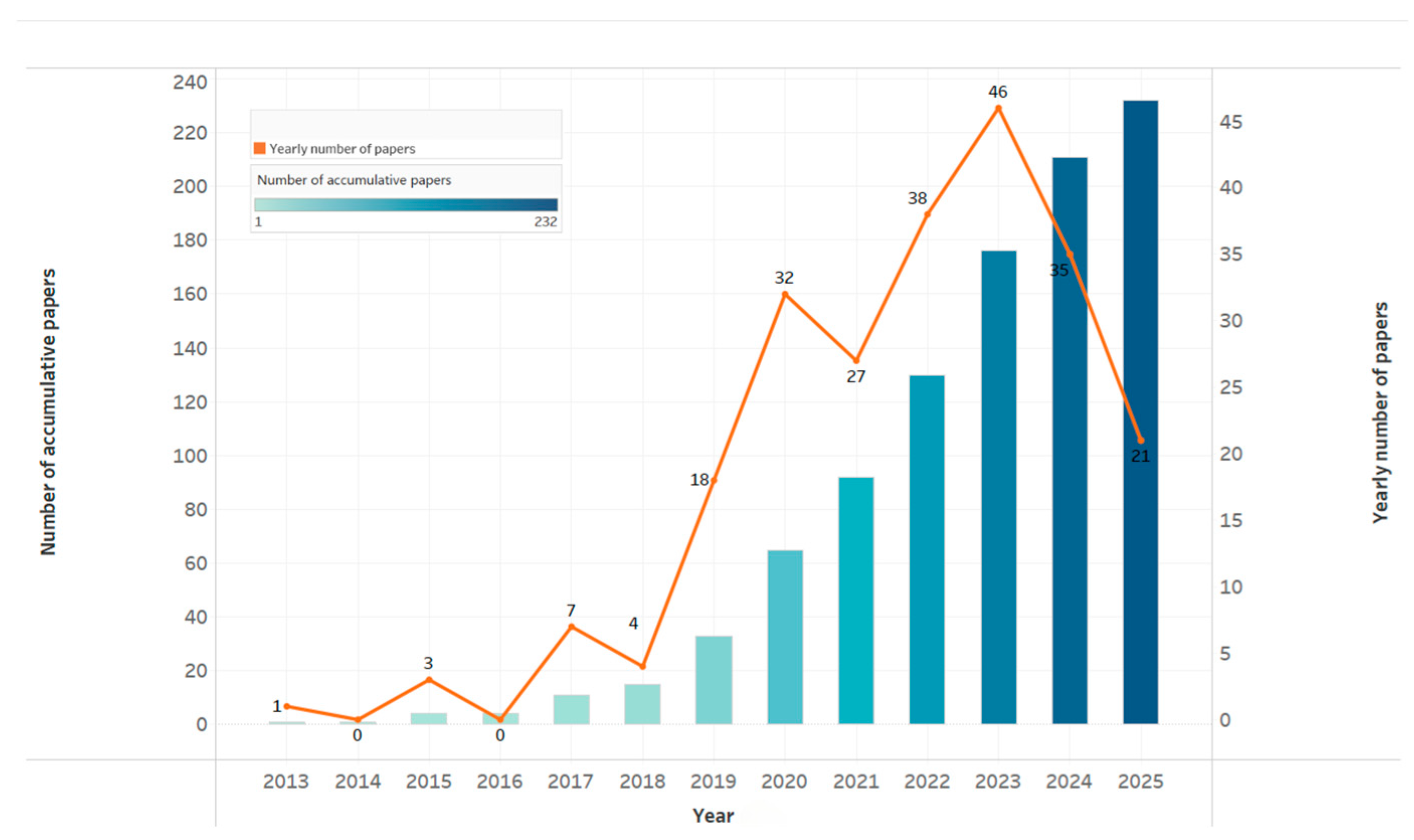
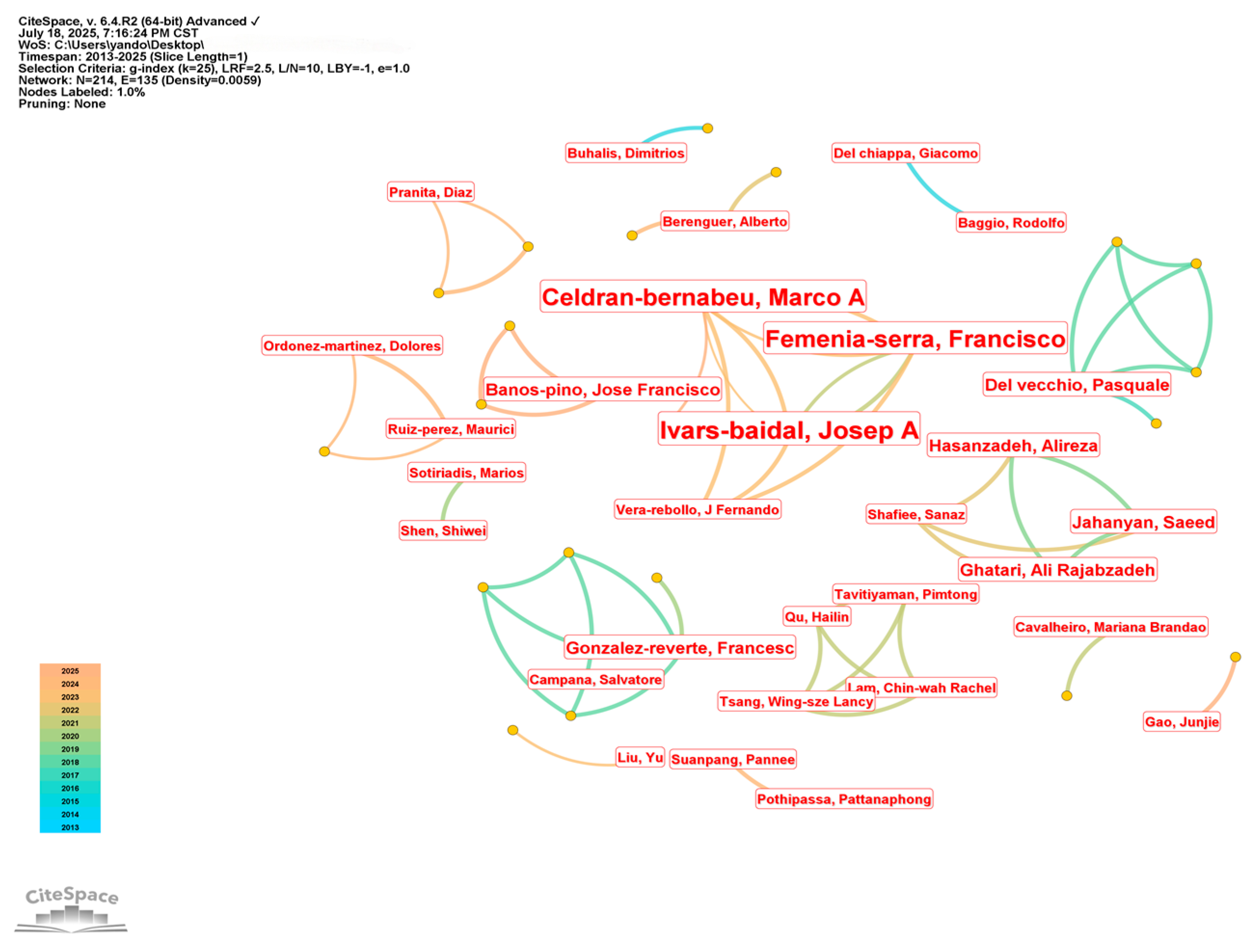
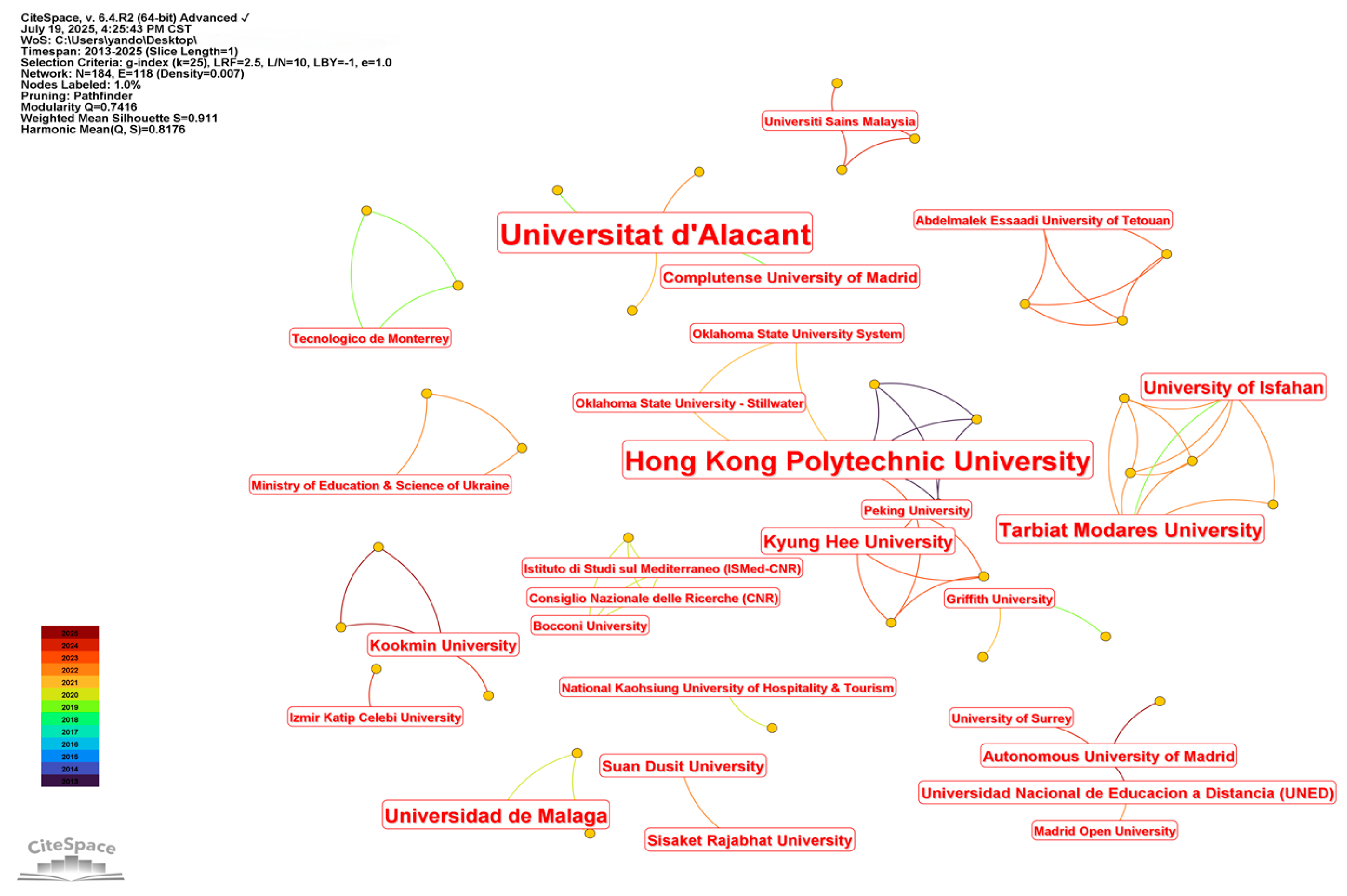
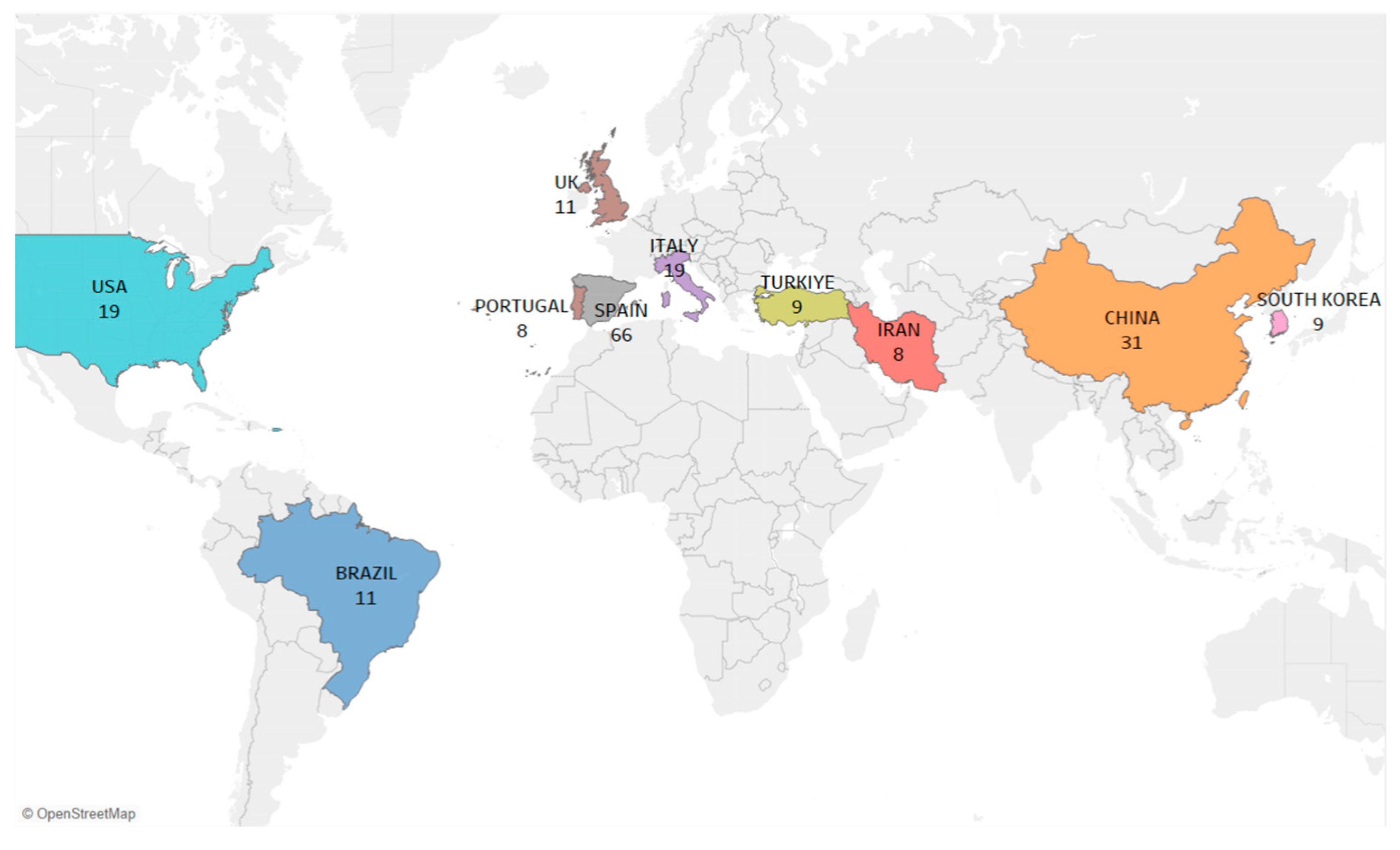
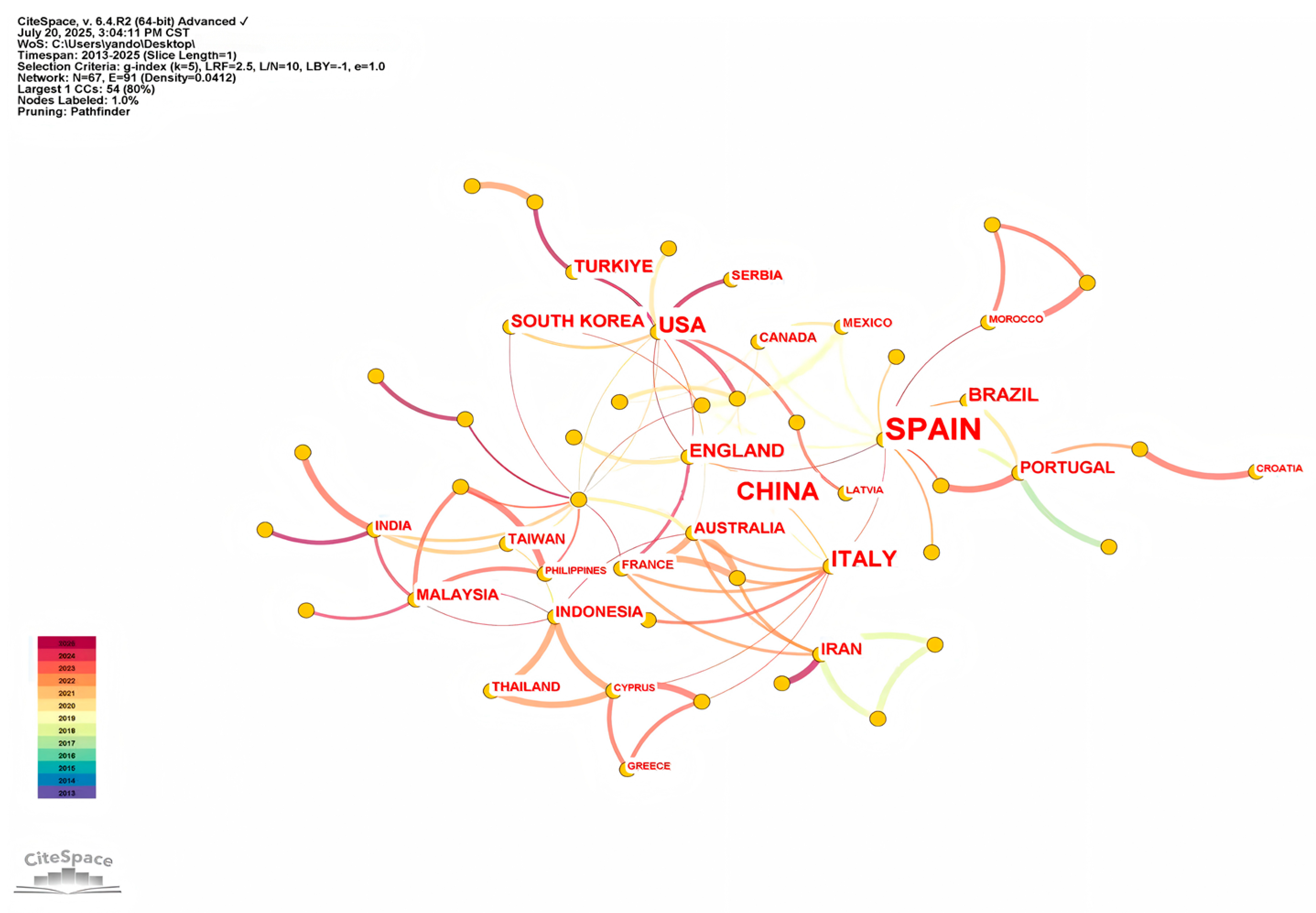

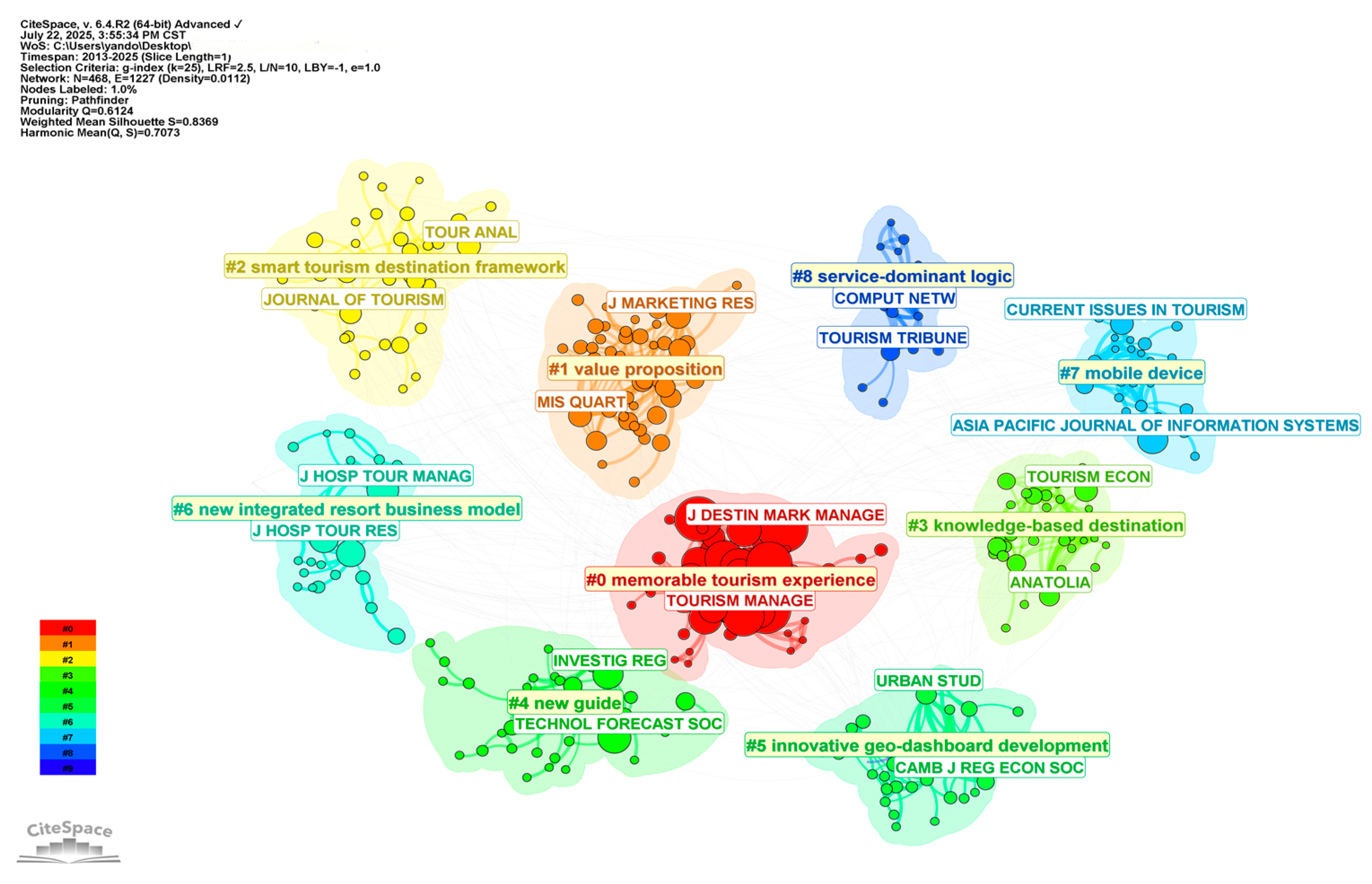
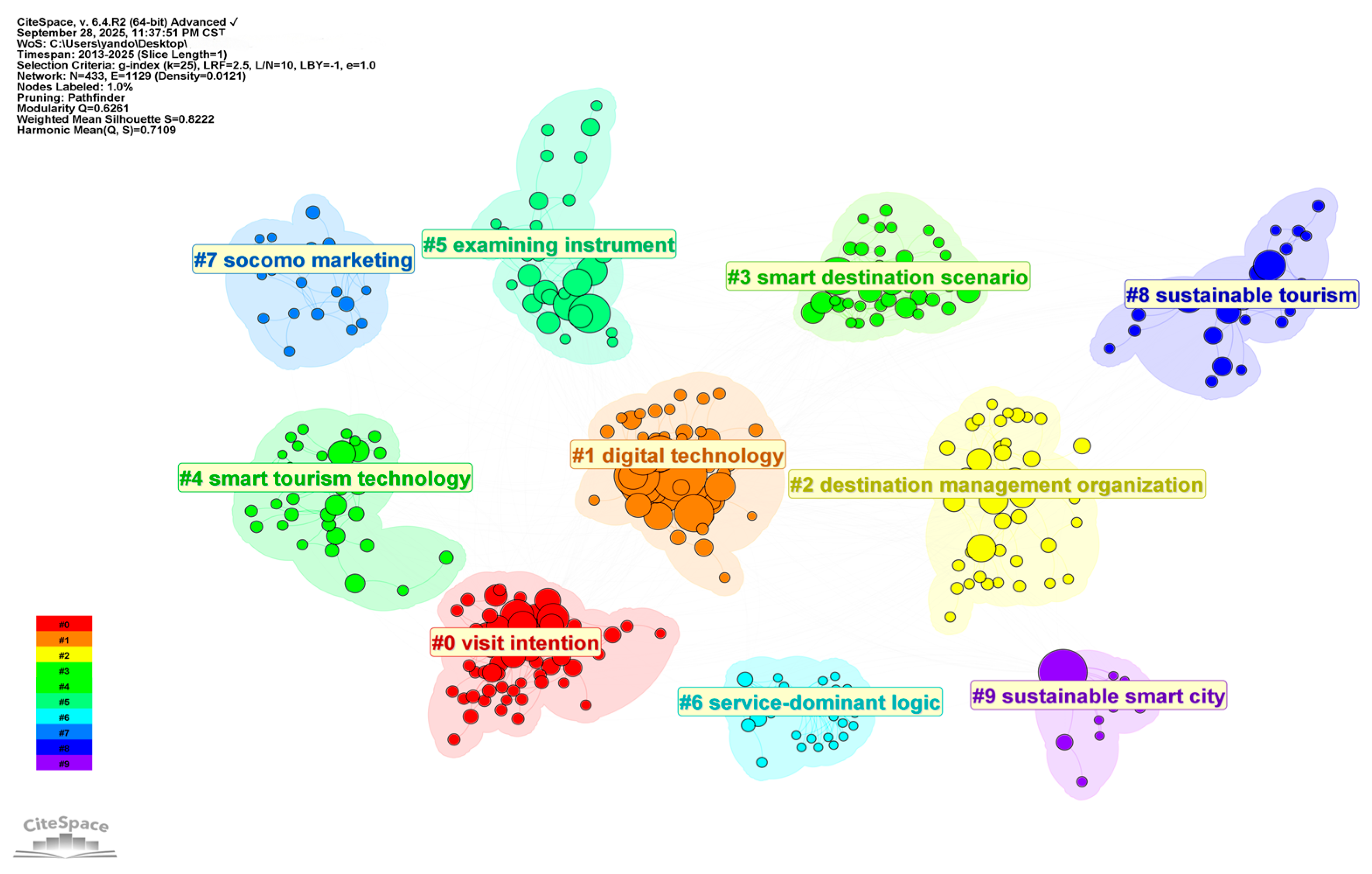
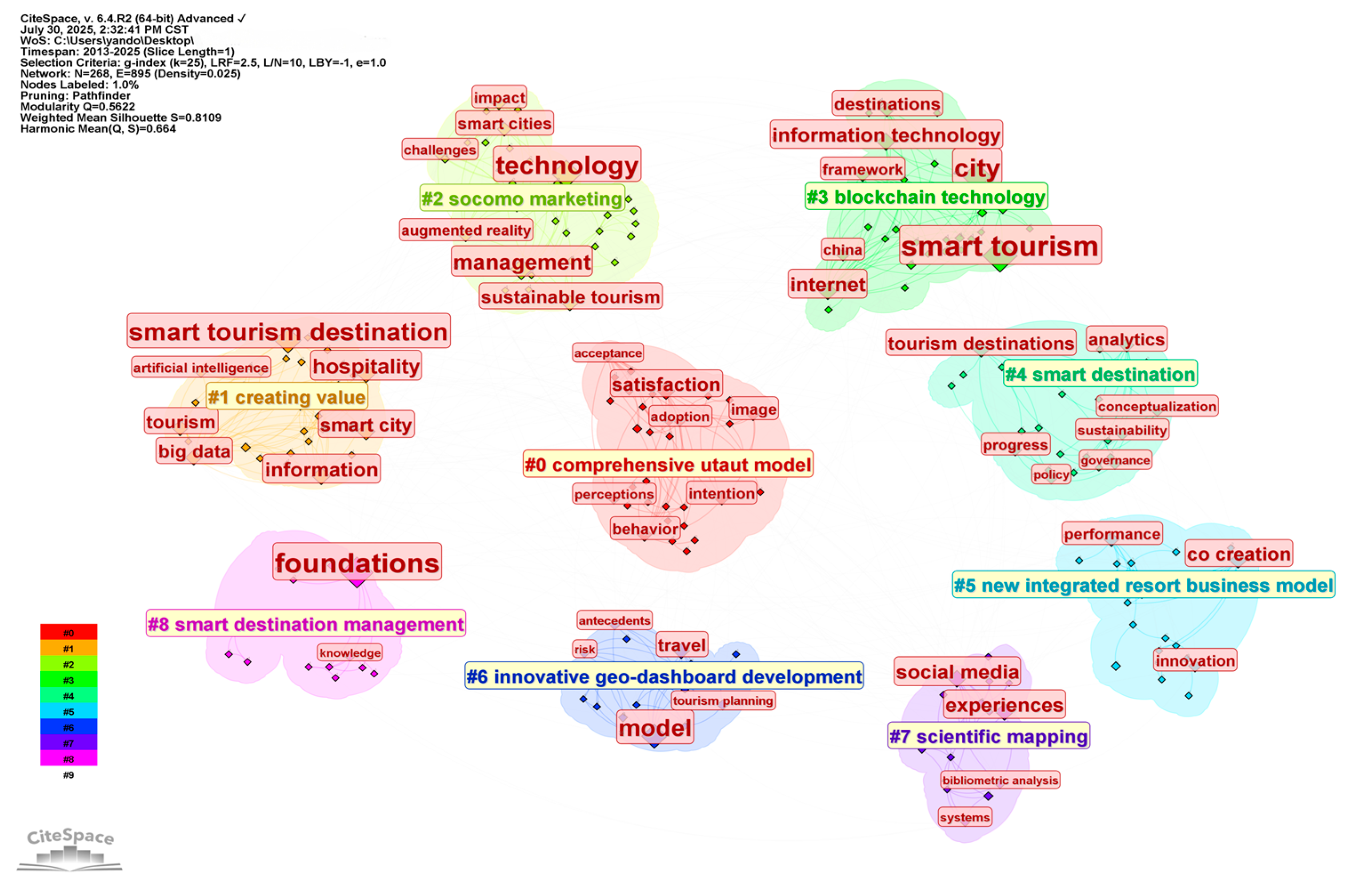


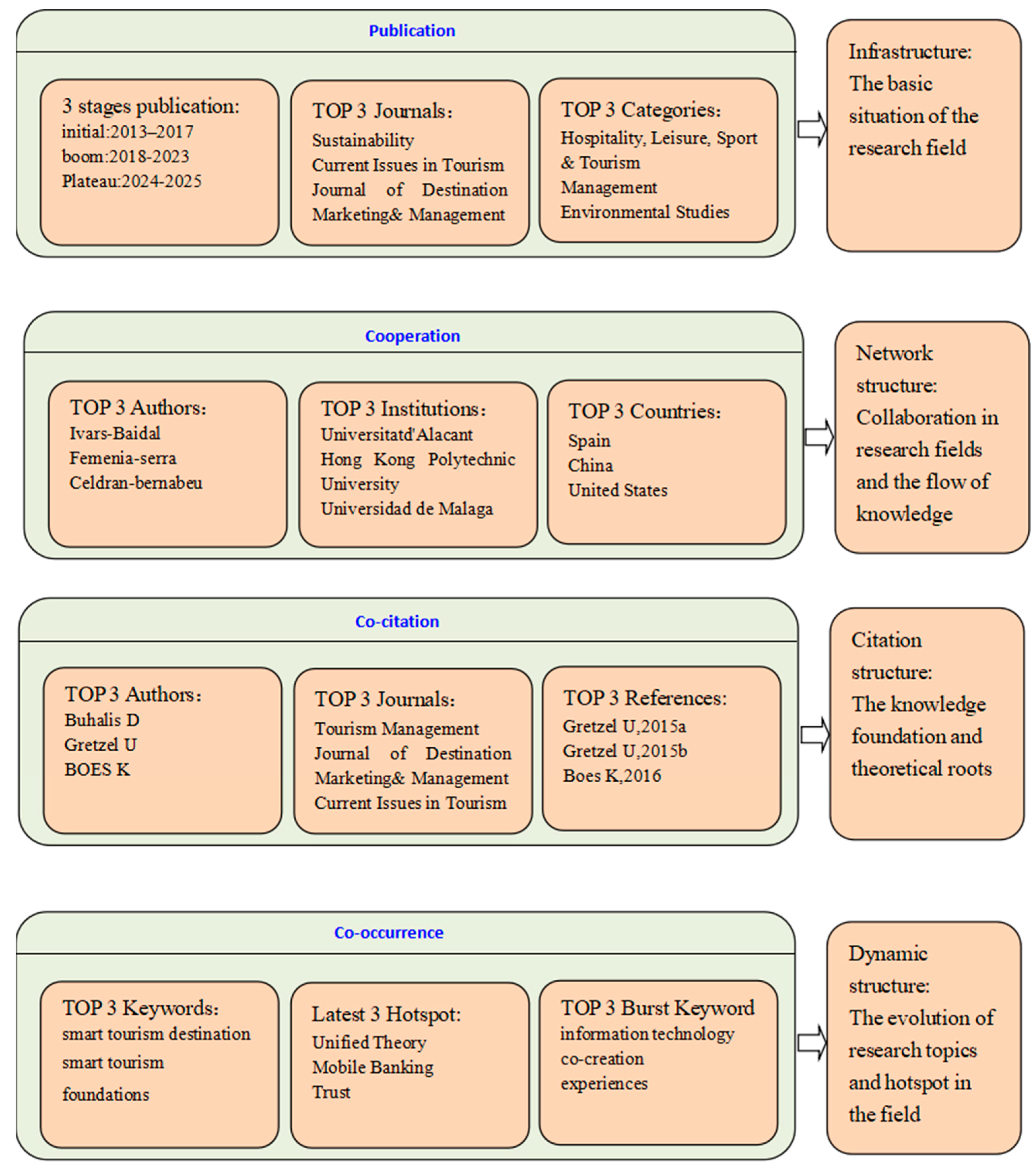
| Rank | Journal | Count | Percentage |
|---|---|---|---|
| 1 | Sustainability | 30 | 12.93% |
| 2 | Current Issues in Tourism | 16 | 6.90% |
| 3 | Journal of Destination Marketing Management | 16 | 6.90% |
| 4 | Worldwide Hospitality and Tourism Themes | 10 | 4.31% |
| 5 | Tourism Review | 9 | 3.88% |
| 6 | Journal of Hospitality and Tourism Technology | 8 | 3.45% |
| 7 | Asia Pacific Journal of Tourism Research | 7 | 3.02% |
| 8 | Tourism Management Perspectives | 7 | 3.02% |
| 9 | International Journal of Tourism Cities | 5 | 2.16% |
| 10 | Journal of Tourism Futures | 5 | 2.16% |
| Rank | Web of Science Categories | Count | Percentage |
|---|---|---|---|
| 1 | Hospitality Leisure Sport Tourism | 134 | 57.76% |
| 2 | Management | 42 | 18.10% |
| 3 | Environmental Studies | 35 | 15.09% |
| 4 | Green Sustainable Science Technology | 34 | 14.66% |
| 5 | Environmental Sciences | 32 | 13.79% |
| 6 | Computer Science Information Systems | 10 | 4.31% |
| 7 | Business | 9 | 3.88% |
| 8 | Engineering Electrical Electronic | 7 | 3.02% |
| 9 | Telecommunications | 6 | 2.59% |
| 10 | Economics | 5 | 2.16% |
| Rank | Article | Citations |
|---|---|---|
| 1 | SoCoMo marketing for travel and tourism: Empowering co-creation of value; Buhalis, D and Foerste, M; 2015; | 308 |
| 2 | The digital revolution in the travel and tourism industry; Pencarelli, T; 2020; | 302 |
| 3 | Tourism analytics with massive user-generated content: A case study of Barcelona; Marine-Roig, E and Clavé, SA; 2015; | 234 |
| 4 | Tourists’ Experiences with Smart Tourism Technology at Smart Destinations and Their Behavior Intentions; Jeong, M and Shin, HH; 2020; | 232 |
| 5 | Knowledge transfer in smart tourism destinations: Analyzing the effects of a network structure; Del Chiappa, G and Baggio, R; 2015; | 225 |
| 6 | Creating value from Social Big Data: Implications for Smart Tourism Destinations; Del Vecchio, P; Mele, et al., 2018; | 224 |
| 7 | China’s “smart tourism destination” initiative: A taste of the service-dominant logic; Wang, D; Li, X and Li, YP; 2013; | 213 |
| 8 | Smart destinations and the evolution of ICTs: a new scenario for destination management?; Ivars-Baidal, JA; Celdrán-Bernabeu, MA et al., 2019; | 203 |
| 9 | From the traditional understanding of tourism destination to the smart tourism destination; Jovicic, DZ; 2019; | 168 |
| 10 | Developing a model for sustainable smart tourism destinations: A systematic review; Shafiee, S; Ghatari, AR; 2019; | 141 |
| Rank | Count | Year | Author |
|---|---|---|---|
| 1 | 7 | 2019 | Ivars-baidal, Josep A |
| 2 | 6 | 2019 | Femenia-serra, Francisco |
| 3 | 6 | 2019 | Celdran-bernabeu, Marco A |
| 4 | 3 | 2023 | Banos-pino, Jose Francisco |
| 5 | 3 | 2019 | Ghatari, Ali Rajabzadeh |
| 6 | 3 | 2019 | Hasanzadeh, Alireza |
| 7 | 3 | 2019 | Jahanyan, Saeed |
| 8 | 3 | 2018 | Gonzalez-reverte, Francesc |
| 9 | 3 | 2017 | Del vecchio, Pasquale |
| 10 | 2 | 2024 | Suanpang, Pannee |
| Rank | Count | Year | Institution |
|---|---|---|---|
| 1 | 16 | 2019 | Universitat d’Alacant |
| 2 | 12 | 2013 | Hong Kong Polytechnic University |
| 3 | 5 | 2020 | Universidad de Malaga |
| 4 | 5 | 2019 | Tarbiat Modares University |
| 5 | 4 | 2019 | University of Isfahan |
| 6 | 4 | 2017 | Kyung Hee University |
| 7 | 3 | 2022 | Sisaket Rajabhat University |
| 8 | 3 | 2019 | Parthenope University Naples |
| 9 | 3 | 2022 | Kookmin University |
| 10 | 3 | 2022 | Universidad Nacional de Educacion a Distancia (UNED) |
| Rank | Count | Centrality | Year | Cited Author |
|---|---|---|---|---|
| 1 | 171 | 0.04 | 2015 | BUHALIS D |
| 2 | 167 | 0.01 | 2017 | GRETZEL U |
| 3 | 125 | 0.14 | 2015 | BOES K |
| 4 | 97 | 0.03 | 2019 | IVARS-BAIDAL JA |
| 5 | 82 | 0.03 | 2019 | FEMENIA-SERRA F |
| 6 | 79 | 0.04 | 2015 | WANG D |
| 7 | 79 | 0.05 | 2015 | XIANG Z |
| 8 | 69 | 0.03 | 2019 | JOVICIC DZ |
| 9 | 59 | 0.05 | 2018 | NEUHOFER B |
| 10 | 55 | 0.09 | 2017 | DEL CHIAPPAG |
| Rank | Count | Centrality | Year | 5-Year IF | Cited Journal |
|---|---|---|---|---|---|
| 1 | 179 | 0.01 | 2015 | 13.6 | TOURISM MANAGE |
| 2 | 164 | 0.02 | 2015 | 9.2 | J DESTIN MARK MANAGE |
| 3 | 158 | 0.01 | 2015 | 6.3 | CURR ISSUES TOUR |
| 4 | 140 | 0.01 | 2019 | 3.6 | SUSTAINABILITY-BASEL |
| 5 | 137 | 0.05 | 2013 | 9.8 | J TRAVEL RES |
| 6 | 136 | 0.02 | 2017 | 10 | ELECTRON MARK |
| 7 | 130 | 0.02 | 2015 | 11.1 | ANN TOURISM RES |
| 8 | 125 | 0.01 | 2015 | N/A | INFORM COMMUNICATION |
| 9 | 119 | 0.03 | 2017 | 3.0 | INT J TOUR CITIES |
| 10 | 113 | 0.01 | 2019 | 8.3 | TOUR MANAG PERSPECT |
| Rank | Count | Centrality | Year | Cited References |
|---|---|---|---|---|
| 1 | 125 | 0.02 | 2015 | Gretzel U, 2015, ELECTRON MARK, V25, P179, Smart tourism: foundations and developments |
| 2 | 92 | 0.09 | 2016 | Boes K, 2016, INT J TOUR CITIES, V2, P108, Smart tourism destinations: ecosystems for destination competitiveness |
| 3 | 79 | 0.01 | 2015 | Gretzel U, 2015, COMPUT HUM BEHAV, V50, P558, Conceptual foundations for understanding smart tourism ecosystems |
| 4 | 71 | 0.02 | 2019 | Ivars-Baidal JA, 2019, CURR ISSUES TOUR, V22, P1581, Smart destinations and the evolution of ICTs: a new scenario for destination management? |
| 5 | 62 | 0.05 | 2015 | Buhalis D, 2015, INFORMATION AND COMMUNICATION TECHNOLOGIES IN TOURISM 2015, V0, P0, Smart Tourism Destinations Enhancing Tourism Experience Through Personalisation of Services |
| 6 | 60 | 0.03 | 2013 | Wang D, 2013, J DESTIN MARK MANAGE, V2, P59, China’s “smart tourism destination” initiative: A taste of the service-dominant logic |
| 7 | 57 | 0.04 | 2013 | Buhalis D, 2013, INFORM COMMUNICATION, V0, PP553, Smart Tourism Destinations |
| 8 | 56 | 0.06 | 2015 | Boes K, 2015, INFORMATION AND COMMUNICATION TECHNOLOGIES IN TOURISM, V0, P0, Conceptualising Smart Tourism Destination Dimensions |
| 9 | 53 | 0.02 | 2015 | Del Chiappa G, 2015, J DESTIN MARK MANAGE, V4, P145, Knowledge transfer in smart tourism destinations: Analyzing the effects of a network structure |
| 10 | 46 | 0.12 | 2016 | Buonincontri P, 2016, INF TECHNOL TOUR, V16, P285, The experience co-creation in smart tourism destinations: a multiple case analysis of European destinations |
Disclaimer/Publisher’s Note: The statements, opinions and data contained in all publications are solely those of the individual author(s) and contributor(s) and not of MDPI and/or the editor(s). MDPI and/or the editor(s) disclaim responsibility for any injury to people or property resulting from any ideas, methods, instructions or products referred to in the content. |
© 2025 by the authors. Licensee MDPI, Basel, Switzerland. This article is an open access article distributed under the terms and conditions of the Creative Commons Attribution (CC BY) license (https://creativecommons.org/licenses/by/4.0/).
Share and Cite
Yan, D.; Marzuki, A.B.; Yang, J.; Zhou, J.; Tao, S. Bibliometric Analysis of Smart Tourism Destination: Knowledge Structure and Research Evolution (2013–2025). Tour. Hosp. 2025, 6, 194. https://doi.org/10.3390/tourhosp6040194
Yan D, Marzuki AB, Yang J, Zhou J, Tao S. Bibliometric Analysis of Smart Tourism Destination: Knowledge Structure and Research Evolution (2013–2025). Tourism and Hospitality. 2025; 6(4):194. https://doi.org/10.3390/tourhosp6040194
Chicago/Turabian StyleYan, Dongpo, Azizan Bin Marzuki, Jiejing Yang, Jinghong Zhou, and Silin Tao. 2025. "Bibliometric Analysis of Smart Tourism Destination: Knowledge Structure and Research Evolution (2013–2025)" Tourism and Hospitality 6, no. 4: 194. https://doi.org/10.3390/tourhosp6040194
APA StyleYan, D., Marzuki, A. B., Yang, J., Zhou, J., & Tao, S. (2025). Bibliometric Analysis of Smart Tourism Destination: Knowledge Structure and Research Evolution (2013–2025). Tourism and Hospitality, 6(4), 194. https://doi.org/10.3390/tourhosp6040194







